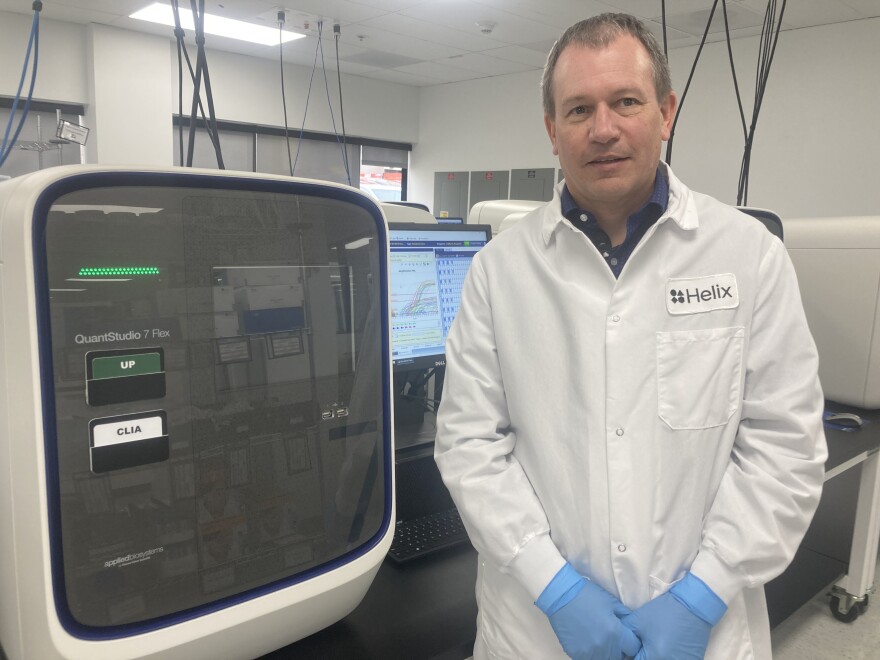Marc Laurent gives a tour of a sprawling set of labs that Helix just opened in San Diego’s Sorrento Valley. There’s a row of white sample testing machines that takes Laurent back to the COVID-19 pandemic and the thousands of samples the company’s technicians tested every day.
“For COVID we ran them on these PCR machines here that essentially allows us to give a yes or no answer. Do you have COVID or do you not have COVID,” said Laurent, the vice president of operations at Helix.
But a thumbs up or down on a COVID-19 test wasn’t the only thing Helix learned from those samples.
“Then what we would do is to take the samples that were positive, people who actually had COVID, and then we would take them back to the beginning of the process and do what we called viral sequencing,” he said. “So look at the detailed genome of each virus and understand how that virus has evolved and understand what variant it is.”
Helix is a genomics company that partnered with San Diego County and others in 2020 to provide COVID-19 testing to the public. From the pandemic to today, it has also been genetically mapping the mutating virus as it has changed from alpha to delta to omicron.
Three years ago, the pandemic was gathering steam and Helix would soon be running as fast as it could to meet the demand for testing. The company would eventually receive more than $30 million from the National Institutes of Health to become a so-called "mega lab," to ramp up COVID-19 diagnosis nationwide.
“During the pandemic we were running about 30,000 samples a day. And that’s a mind boggling number,” Laurent said with a laugh.
And a lot of tests coming in the door back then were from San Diego County.
The county’s Health and Human Services Agency was the first line of defense in San Diego’s war against COVID-19. Early on, it was clear that the county’s labs simply couldn’t process enough COVID-19 tests. Health department director Nick Macchione said he asked just about everyone he knew how he could solve that testing dilemma.
“I reached out to my friend Joe Panetta at Biocom. I said, 'Are there any companies doing this?' He mentioned a couple of them and he also mentioned Helix,” Macchione said.
Lab supplies and chemicals needed to test for the virus were in short supply in 2020. Macchione said Helix officials had a different supply chain from the county and they were using different reagents, substances used in chemical analysis, to perform the tests.
When the county and Helix agreed to work together, Laurent said the company hired more than 200 additional people and it began to use a liquid robotic testing system to help meet the demand.

Macchione said the arrangement set up with Helix was the foundation of the county’s pandemic health system. COVID-19 testing led to COVID-19 tracing to track the virus in the population.
Ultimately mass vaccination centers, like the one outside Petco Park, gave thousands of people their COVID-19 shots every day. Macchione now looks back on the testing partnership between Helix and San Diego county as novel and successful.
“It was a public-private partnership for the public good,” he said.
That partnership has ended up being worth more than $88 million in San Diego County contracts for Helix. Machionne insisted the price they paid during the pandemic — about $50 per test — was a good deal. It was about half of what other companies were asking, he said.
Viral surveillance after the pandemic
Today, Helix continues to sequence the genomes of both people and viruses. On one side of the business, Helix works with health care systems to sequence the genomes of patients. That process can pinpoint health risks on an individual level.
Its viral surveillance program targets the genomes of viruses like COVID-19, to learn how they behave and, hopefully, stop the next pandemic before it happens.
During the recent pandemic the COVID-19 virus, called SARS-CoV-2, began to behave unlike a typical coronavirus. Helix’s head of infectious diseases, Shishi Luo, said the coronavirus is pretty slow moving compared to the flu. But it moved pretty quick during the pandemic.
“I think when the COVID pandemic happened there were so many people getting infected that even though the base rate of mutation is lower, there were a lot more opportunities for the virus to replicate,” Luo said.
“So you can have a lower mutation rate but more replication, more infections, and you can also generate the same amount of change, or a greater amount of change.”
Today, Luo said the latest dominant sub-variant of the COVID-19 virus, XBB, has been in the U.S. since the beginning of the year. So far it has not posed a serious threat.
“There is enough pre-existing immunity, whether it’s a vaccination or an infection, that it would take a lot to cause a huge surge again. But we should also be prepared for the worst,” Luo said.
COVID-19 samples continue to come in the door at Helix for testing. Samples are also tested for other respiratory viruses like the flu.
Laurent said the lab will soon test for another contagious disease that’s seen a recent outbreak: the virus called mpox, formerly known as monkeypox.






